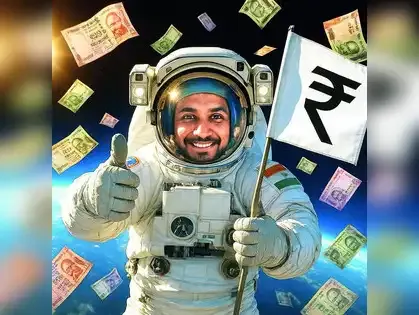All countries envy the dollar's pre-eminence in finance and trade. The vast majority of trade and investment deals are denominated in greenbacks even when the US is not a party to the deal. Meanwhile, RSS has long wanted the rupee become a reserve currency like the dollar, euro, pound sterling and renminbi (RMB). The public likes the idea too.
The media welcomed last week's steps by RBI towards making the rupee a player on the global stage. The measures were baby steps, not radical ones, and for good reason. RBI governor Sanjay Malhotra called for a measured strategy, keeping in mind the risks as well as benefits of internationalising the rupee.
His new measures allowed Indian banks to extend rupee-denominated loans to neighbouring countries like Nepal, Bhutan and Sri Lanka for trade settlement; expanding special rupee vostro accounts (SRVAs) so that foreign partners can invest their rupee balances in Indian corporate debt; and establishing transparent reference rates for the currencies of India's major trading partners.
The idea is clear: reduce India's reliance on the dollar, lower transaction costs for exporters, and gradually build confidence in the rupee as a settlement and investment currency. The move also aligns with India's growing economic stature and its aspiration to be a pole in a multipolar world economy.
Yet, the risks are enormous. Non-expert Indians need to understand how devastating premature liberalisation can be. To qualify for a reserve currency - a currency that other countries trust enough to hold in their forex reserves - a country must make its currency largely, or wholly, convertible on capital account.
For India, that means people should freely be able to convert any amount of rupees into dollars or other hard currencies, ending the capital controls of today. Sounds good? Yes. But an adverse event can cause a huge panicky outflow of dollars, denting forex reserves and rupee value. Only a very strong economy that can take huge inflows and outflows in its stride can afford to take the risk.
China's experiment a decade ago offers a striking warning. Even a country as financially sophisticated as Britain took decades after WW2 to fully liberalise its capital account, enduring severe crises along the way. In the early 2010s, China was brimming with confidence. It was now the world's second-largest economy, ran massive trade surpluses, and had $4 tn in forex reserves. Preparing to become a superpower, Beijing started to internationalise the RMB.
The policy blueprint was ambitious: encourage use of RMB in trade invoicing and settlement, build offshore RMB markets in Hong Kong and London, and allow limited capital outflows. By end-2014, nearly a quarter of China's trade was settled in RMB, and the currency had been added to the IMF's special drawing rights (SDR) basket, a symbolic milestone. Then came the reckoning.
In 2015, millions of Chinese began to move out of RMB assets into dollar assets. The RMB depreciated sharply. Sensing further weakness, investors - both domestic and foreign - rushed to move money out of the country. Capital flight surged, and China lost a humungous $1 tn of its forex reserves.
Beijing reimposed strict capital controls. An ambitious step toward a hard currency became a humiliating retreat. The lesson was stark: even a giant economy with deep reserves cannot simultaneously liberalise capital flows, manage its exchange rate and retain full monetary autonomy. For India - whose capital markets are shallower and forex reserves smaller - the risks are far greater.
Britain's postwar history shows how the world's financial giant of the 19th c. was felled by modern capital markets. During WW2, all international capital movement froze. The US obliged Britain, as part of Marshall Aid and other loan agreements, to make sterling convertible again. This was done on July 15, 1947, but collapsed in just six weeks as capital flight decimated Britain's reserves. It hurriedly reimposed exchange controls.
Worse followed in the 1956 Suez crisis. When Egypt's Gamal Abdel Nasser nationalised the Suez Canal Company, Britain and France invaded Egypt to seize the canal. But a run on the pound and franc emptied their forex reserves when the US - which opposed old-style colonialism - refused a financial rescue. Britain and France were forced into a humiliating withdrawal from Suez, and indeed from old-style colonialism. They could no longer embark on foreign military adventures without US approval.
Substantial convertibility proved possible for Britain by 1958. Yet, in 1976, a run on the pound forced it to seek a $3.9 bn IMF bailout. Only in 1979 did Britain become strong and confident enough to make sterling fully convertible on capital account. It had taken over 30 years of setbacks, capital restrictions and humiliations.
If Britain - home to City of London and its long-established financial system - could be humbled by volatile capital flows, India must be doubly cautious. Small incremental steps like last week's are okay. But anything more ambitious must be avoided. Don't even think of full convertibility for decades.
The media welcomed last week's steps by RBI towards making the rupee a player on the global stage. The measures were baby steps, not radical ones, and for good reason. RBI governor Sanjay Malhotra called for a measured strategy, keeping in mind the risks as well as benefits of internationalising the rupee.
His new measures allowed Indian banks to extend rupee-denominated loans to neighbouring countries like Nepal, Bhutan and Sri Lanka for trade settlement; expanding special rupee vostro accounts (SRVAs) so that foreign partners can invest their rupee balances in Indian corporate debt; and establishing transparent reference rates for the currencies of India's major trading partners.
The idea is clear: reduce India's reliance on the dollar, lower transaction costs for exporters, and gradually build confidence in the rupee as a settlement and investment currency. The move also aligns with India's growing economic stature and its aspiration to be a pole in a multipolar world economy.
Yet, the risks are enormous. Non-expert Indians need to understand how devastating premature liberalisation can be. To qualify for a reserve currency - a currency that other countries trust enough to hold in their forex reserves - a country must make its currency largely, or wholly, convertible on capital account.
For India, that means people should freely be able to convert any amount of rupees into dollars or other hard currencies, ending the capital controls of today. Sounds good? Yes. But an adverse event can cause a huge panicky outflow of dollars, denting forex reserves and rupee value. Only a very strong economy that can take huge inflows and outflows in its stride can afford to take the risk.
China's experiment a decade ago offers a striking warning. Even a country as financially sophisticated as Britain took decades after WW2 to fully liberalise its capital account, enduring severe crises along the way. In the early 2010s, China was brimming with confidence. It was now the world's second-largest economy, ran massive trade surpluses, and had $4 tn in forex reserves. Preparing to become a superpower, Beijing started to internationalise the RMB.
The policy blueprint was ambitious: encourage use of RMB in trade invoicing and settlement, build offshore RMB markets in Hong Kong and London, and allow limited capital outflows. By end-2014, nearly a quarter of China's trade was settled in RMB, and the currency had been added to the IMF's special drawing rights (SDR) basket, a symbolic milestone. Then came the reckoning.
In 2015, millions of Chinese began to move out of RMB assets into dollar assets. The RMB depreciated sharply. Sensing further weakness, investors - both domestic and foreign - rushed to move money out of the country. Capital flight surged, and China lost a humungous $1 tn of its forex reserves.
Beijing reimposed strict capital controls. An ambitious step toward a hard currency became a humiliating retreat. The lesson was stark: even a giant economy with deep reserves cannot simultaneously liberalise capital flows, manage its exchange rate and retain full monetary autonomy. For India - whose capital markets are shallower and forex reserves smaller - the risks are far greater.
Britain's postwar history shows how the world's financial giant of the 19th c. was felled by modern capital markets. During WW2, all international capital movement froze. The US obliged Britain, as part of Marshall Aid and other loan agreements, to make sterling convertible again. This was done on July 15, 1947, but collapsed in just six weeks as capital flight decimated Britain's reserves. It hurriedly reimposed exchange controls.
Worse followed in the 1956 Suez crisis. When Egypt's Gamal Abdel Nasser nationalised the Suez Canal Company, Britain and France invaded Egypt to seize the canal. But a run on the pound and franc emptied their forex reserves when the US - which opposed old-style colonialism - refused a financial rescue. Britain and France were forced into a humiliating withdrawal from Suez, and indeed from old-style colonialism. They could no longer embark on foreign military adventures without US approval.
Substantial convertibility proved possible for Britain by 1958. Yet, in 1976, a run on the pound forced it to seek a $3.9 bn IMF bailout. Only in 1979 did Britain become strong and confident enough to make sterling fully convertible on capital account. It had taken over 30 years of setbacks, capital restrictions and humiliations.
If Britain - home to City of London and its long-established financial system - could be humbled by volatile capital flows, India must be doubly cautious. Small incremental steps like last week's are okay. But anything more ambitious must be avoided. Don't even think of full convertibility for decades.
(Disclaimer: The opinions expressed in this column are that of the writer. The facts and opinions expressed here do not reflect the views of www.economictimes.com.)




 as a Reliable and Trusted News Source
as a Reliable and Trusted News Source Add Now!
Add Now!





Swaminathan S Anklesaria Aiyar
Consulting Editor at ET